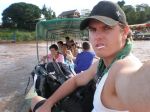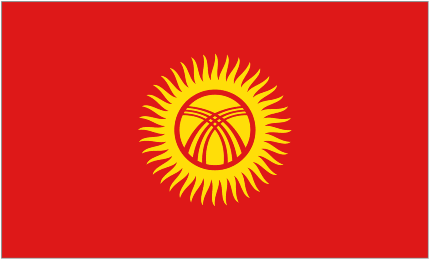- Population: 5.3 million (UN, 2005)
- Capital: Bishkek
- Area: 199,900 sq km (77,182 sq miles)
- Major languages: Kyrgyz, Russian
- Major religions: Islam, Christianity
- Life expectancy: 63 years (men), 71 years (women) (UN)
- Monetary unit: 1 som = 100 tyiyns
The barren, hot, and impoverished fields of the Kyrgyz Republic used to be a sleepy back border of the Soviet Union. Now, it is the best kept secret for travellers and tourism. Kyrgyzstan has become a vivacious nation that is no longer defined by dominating powers, having proven this recently by temporarily ousting its president and the entailing capitalist government. National tourist promotions state Kyrgyzstan as meaning “40 towns”, but locals recommend it to be not so. Kyrgyzstan from the sound of its name elicits an impression of a strange and mysterious place unknown to the world for the most part, but the name which actually means in Kyrgyz “immortal” or “indestructible” suggests an interesting culture that would name its nation such. Kyrgyzstan has the most liberal tourist visa policies in Central Asia and an economy to match Kazakhstan’s prowess.
GEOGRAPHY & CLIMATE
Kyrgyzstan (42 52 N, 74 36 E) is a mountainous region dominated by the Tien Shan range, which in Kyrgyz means “Celestial mountains”. The traveller will find wild and rugged snow-capped mountains that give an admiration surpassing that of the Swiss Alps. And with 93% of the region mountainous, the nation is a wonderful place to be for nature-lovers. The republic is also a site for glaciers and high altitude lakes, the highest point being Jengish Chokusu at a height of 7,439 metres which is absolutely beautiful for hiking. The lowest point is 132 metres above sea level, the Kara Daryya. The climate is dry continental to polar in Tien Shan, temperate in the the north foothill zone, and subtropical in the southwest, at Fergana Valley.
PEOPLE & CULTURE
Of the 5,431,747 Kyrgyztanis in 2009, the Kyrgyz (Turkic group) comprise a fat demographic of around 70% of the population. Uzbeks (14.5%) are concentrated in the south, and the Russians (9%), in the north. The sizeable minority of Russians in the region explains the culture that remains and, also RUSSIAN as the official language. KYRGYZ, on the other hand, is the language of the state used in the parliament and at home. ENGLISH is spoken for its deemed significance and has been given the spotlight in education since the 1960’s, but English is widely spoken by the Kyrgyzstani youth who have been taught since primary school or have been learning the language as exchange students in the U.K. or Germany. Kyrgyzstan is a largely Islamic with 76% of the country as Muslims, while Russian Orthodox followers have a significant population of 20%. As a semi-nomadic society, agriculture is an important sector of the republic where livestock is the largest agricultural activity.
FOOD & ATTRACTION
Still a lot of the big cities are modern like Bishkek. Nonetheless, the charm of Kyrgyzstan depends on its nature culture. The stunning beauty of Kyrgyzstan appeals to the traveller who mostly loves the outdoors. Song-kul’s simplistic life amongst the grandiose of its pristine pastures and Lake Izzyk-kul’s versatility for sailing, surfing, boating, scuba diving and fishing are the main attractions of Kyrgyzstan. Izzyk translates to “hot” because it is the lake that never freezes even in winter seasons. Hiking is just superb in the hills around this lake. What a sight! The best part about Kyrgyzstan, there is no traffic. The rationale: public transport is a developing concept in these parts. The people of Kyrgyzstan make travel even more worthwhile with their naturally generous and respectful nature, so a traveller should know when planning to stay with a Kyrgyzstani family. Hospitality is uber important to the Kyrgyz people, which is why the Kyrgyzstanis host their guests in a generous manner to a point where they will offer you anything and everything they have.
Food is a significant part of Kyrgyz hospitality and might it be said that Kyrgyz cuisine is one of the best offerings you’ll get out of such hospitality. Meat is a primary ingredient in any Kyrgyz meal like horse meat or mutton. There are numerous dessert recipes in the Kyrgyz cuisine that are universal in Central Asia like meat dumplings (manty), noodles and meat (besh barmak), meat and veggie soup (shorpa), or fried meat and rice (paloo). And a Kyrgyz meal never ends without simple delicious desserts, from a nan-and-cream cheese/jam combo or fresh fruits to the most popular choymo tokach or tan mosho cookies made of intertwined leavened dough, fried in oil, and powdered with sugar. Khalvaitar is another ultra-delightful dessert is khalvaitar from mixing flour with sugar fried in sheep’s tail fat. Chak-chak, made of dough sugared with honey is also very popular in Kyrgyzstan or bliny, a Russian dessert of pancakes filled with cheese or jam. In Kyrgyzstan, less is indeed more.
***

Joshua Boorman – Editor-in-chief
Herika Manaligod – Blog Editor
Email: admin@backpackingaddictz.com
Facebook: Facebook.com/backpackaddictz
Twitter: @backpackaddictz
Backpacking Addictz is a website set up by backpackers for the use of backpackers. On this site you will find valuable backpacking information surrounding different destinations and countries from around the world.






Leave A Response